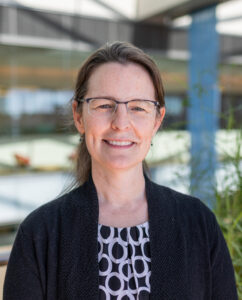
Wendy C. Crone, Ph.D.
Karen Thompson Medhi Professor Emeritus
College of Engineering
University of Wisconsin-Madison
Friday, Sept. 13th at 3:00pm
MEK 3350
ABSTRACT: Human pluripotent stem cell–derived myocytes have emerged as an exciting new tool for research and can serve as a pre-clinical platform for drug development and disease modeling studies. The Crone Lab has produced novel engineered models of both the cardiac syncytium and the myotendinous junction that are amenable to structural, mechanical, and electrical characterization. Micropatterned lanes promote cellular and myofibril alignment while the addition of other micropatterned features enable formation of large synchronously contracting regions.
To form a model of heart tissue, human pluripotent stem cell–derived cardiomyocytes (hPSC-CMs) and cardiac fibroblasts (hPSC-CFs) were seeded onto a substrate with physiological stiffness and patterned extracellular matrix (ECM), creating a cardiac syncytium for in vitro studies. Investigation of electrophysiological properties of the patterned cardiac constructs with optical mapping shows that they have anisotropic electrical impulse propagation, as occurs in the native myocardium. Additionally, when iPSC-CFs are confined to the micropatterned features of the platform they remodel the ECM into anisotropic fibers. Our results also show that iPSC-CFs influence iPSC-CM function with accelerated calcium transient rise-up time and greater contractile strains in co-culture. We also demonstrate the utility of this platform to investigate disease models.
The myotendinous junction (MTJ) is a specialized region at the interface of skeletal muscle and tendon that forms an integrated unit capable of transducing forces. Spatially restrictive co-culture of human embryonic stem cell (hESC)-derived skeletal myocytes and primary tenocytes were used to create a model of the MTJ recapitulating phenotypic alterations to both cell types. Within the patterned lanes, the myocytes begin to form bundles with structural and organizational characteristics present in the muscle and at the junction the myocyte-tenocyte interface is interdigitated. Digital image correlation (DIC) analysis shows coordinated contractile behavior under stimulation and force transduction across the junction. We anticipate this model will have applications in investigating exercise induced MTJ injury, as well as the study of the pathophysiological mechanisms of muscular and tenogenic disorders.
BIO: Wendy C. Crone is the Karen Thompson Medhi Professor Emeritus in the College of Engineering at the University of Wisconsin–Madison. She holds faculty appointments in the Department Mechanical Engineering and the Department of Nuclear Engineering and Engineering Physics, as well as affiliate faculty appointments in the Departments of Biomedical Engineering and Materials Science and Engineering. Her research is in the area of solid mechanics, and many of the topics she has investigated are connected with biotechnology and nanotechnology. She has applied her technical expertise to improving fundamental understanding of mechanical response of materials, enhancing material behavior through surface modification and nanostructuring, exploring the interplay between cells and the mechanics of their surroundings, and developing new material applications and medical devices. Her research has been funded by the National Institutes of Health, National Science Foundation, Department of Energy, Air Force Office of Scientific Research, DARPA and the Whitaker Foundation. Prof. Crone has been recognized with numerous awards for research, teaching and mentoring, and is a Fellow of the Society for Experimental Mechanics. She has served in several leadership roles, including Interim Dean and Associate Dean of the Graduate School at UW-Madison, and President of the Society for
Experimental Mechanics, and Program Director with the National Science Foundation. In addition to numerous publications and several patents, Prof. Crone is the author of two books, Survive and Thrive: A Guide for Untenured Faculty and Introduction to Engineering Research.